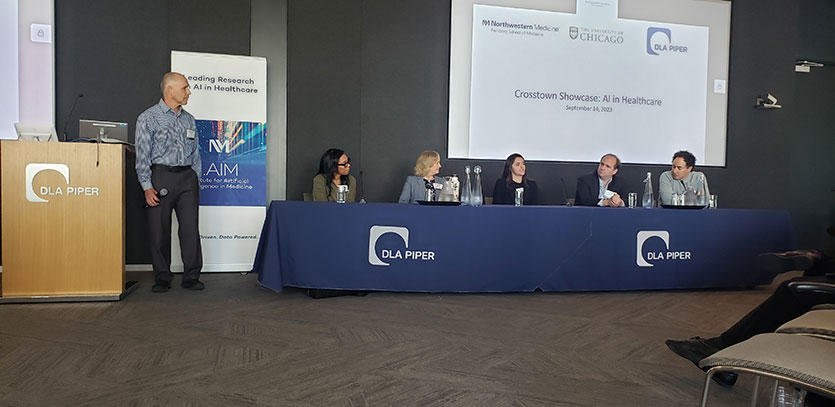Academia, Industry Unite to Showcase AI in Healthcare
While there is a lot of excitement around artificial intelligence (AI), many people don’t have a solid understanding of how the technologies could help them in their everyday lives. Medical professionals who have been working with machines for decades say AI can provide solutions for physicians and patients, but only if tools are developed responsibly.
Northwestern University and the University of Chicago teamed up on Sept. 14 for a discussion about AI’s potential and limitations. The Institute for Artificial Intelligence in Medicine (I.AIM) event, “Crosstown Showcase: AI in Healthcare,” took place in Chicago at DLA Piper, a business law firm, and included participants from industry and academia. The goal was to foster connections and collaborations between businesspeople and academics.
 “We both have our strengths and challenges, but when we bridge the domains, we’ll have more of an impact on society,” said Dr. Abel Kho, director of I.AIM and the Institute for Public Health and Medicine (IPHAM)’s Center for Health Information Partnerships.
“We both have our strengths and challenges, but when we bridge the domains, we’ll have more of an impact on society,” said Dr. Abel Kho, director of I.AIM and the Institute for Public Health and Medicine (IPHAM)’s Center for Health Information Partnerships.
“A lot of the innovation in AI is happening at the academic level. It’s happening at our universities,” said Amit Aysola, managing partner of Create Health Ventures and I.AIM external advisory committee member. “Venture capitalists like me and others in the business ecosystem aren’t necessarily as familiar with what’s going on.”
The event included presentations, question-and-answer sessions, and a panel discussion.
Northwestern’s Research in AI and Healthcare
Kho’s presentation focused on how researchers at Northwestern are using AI. Yuan Luo, associate professor of preventive medicine and chief AI officer at both I.AIM and at the Northwestern Clinical and Translational Sciences Institute (NUCATS), was the lead researcher in a paper that used machine learning to help identify an autism subtype. Dr. Amy Paller, professor of dermatology and chair of its department, and Dr. Antonia Reimer-Taschenbrecker, research fellow at the Department of Dermatology, are co-leading a project with Kho, forming a collaboration between Dermatology, I.AIM, and McCormick School of Engineering. Their goal is to develop a deep-learning AI algorithm that can help diagnose a deadly skin cancer earlier in patients with epidermolysis bullosa, a rare, genetic skin condition.
Several research hubs at the Feinberg School of Medicine use AI, including the seven specialized centers that are housed within I.AIM.
Kho said he is most excited about DAX Express, an AI-automated clinical notetaker. He said technologies like these give physicians more time to listen to their patients instead of getting buried in drudgework.
Kho also encouraged participants to stay updated by subscribing to I.AIM’s monthly newsletter.
“The AI space is evolving so quickly, it’s really hard to keep up,” he said. “We see something as transformational as this as a team sport. Many of us are still trying to feel it out and understand the implications of these technologies.”
Pioneer in Medical Imaging AI Encourages Data-Sharing
AI tools can detect cancer, but their accuracy depends on the data that was fed into them. Maryellen Giger, professor of radiology at the University of Chicago, gave a presentation focusing on her more than four decades of research in AI imaging.
Giger was a cofounder of Quantitative Insights, Inc., which produced QuantX, the first FDA-cleared, machine-learning-driven system to aid in cancer diagnosis.
“AI in breast cancer screening is reaching clinical levels, but we’re not replacing people,” Giger said. She compared working with AI to analyzing blood test results. A medical professional still needs to interpret all the numbers. When a patient undergoes medical imaging, the images are fed into an FDA-approved AI system before the report goes to the provider, who uses it in their decision-making.
Giger encouraged hospitals to share their data to reduce bias in AI systems. She said the Medical Imaging and Data Resource Center (MIDRC) is a place where researchers can get diverse datasets of chest X-ray and CT images to help diagnose and treat COVID-19. The data comes from about 60,000 patients from across the US and can be downloaded for free.
“We will work with smaller institutions. We want diverse data from small, rural hospitals. We proactively go out and look for these sites,” she said.
Northwestern and the University of Chicago will be collaborating to make Northwestern’s diverse database, collated through the All of Us Research Program, available in MIDRC.
Panelists Emphasize AI Education
The event concluded with a panel discussion featuring businesspeople and policymakers, who answered questions about the risks and benefits of AI in healthcare. Panelists were optimistic that AI could help alleviate challenges such as worker burnout and lengthy wait times for patients. However, they also expressed concerns regarding health disparities and the challenge of explaining AI tool usage to patients.
“Basic AI literacy will be needed,” said Keo Shaw, partner at DLA Piper who is part of the company’s FDA Regulatory and AI practices. “The National Institute of Standards and Technology (NIST) framework makes clear that AI literacy is needed from the top down of anyone using these tools. Doctors aren’t the only people using medical AI. Some tools are going straight to the patient. When designing a medical device or tool, we need to think carefully about how it’s labeled and whether people are using it properly.”
“Doctors are decision-makers, and how we engage them is critical,” said Andrew Boyd, University of Illinois-Chicago associate vice chancellor for research in data initiatives and information/chief research information officer. “80% of the workforce doesn’t have skills or training in AI. In medicine, we’ll need to re-educate the workforce. We need doctors, developers, medical teams, and legal teams involved early.”
“In general, clinicians don’t like a lot of change,” said Vanessa Rissetto, registered dietician and co-CEO of Culina Health. “It’s about getting people comfortable with these technologies. If a patient perceives an AI tool to be above their literacy level, then they won’t use it. We need to dive deeper into educating people.”
“The technology will continue to evolve at such rapid a pace that it’ll evolve much faster than whatever educational rubric gets put into place,” said Steven Collens, CEO of healthcare technology incubator MATTER and I.AIM external advisory committee member. “Physicians who have gotten comfortable with medical devices may not know exactly how they work. Somebody needs to understand and vet it for them.”
“How do we leverage AI to improve and scale the education of physicians?” asked Dr. Kim Lomis, vice president of UME Innovations and of the American Medical Association’s undergraduate medical innovations. “There is a lack of diversity among physicians, but there is a path to increase diversity. There’s a movement to make education focused on individual trajectory across a variety of domains. If we can learn to leverage emerging technology, that will contribute to health equity.”




